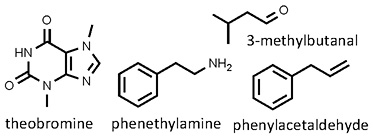 Theobroma cacao
Theobroma cacao
cacao
Back to “Spices: cacao, chocolate (Theobroma cacao)s”
Theobroma cacao L. (Sterculiaceae); kakao (Afrikaans); cacao (French); Kakao (German); cacao (Italian); cacao real (Spanish) DESCRIPTION Ripe seeds (cacao beans) are about 25 mm (or 1 in.) long, with a reddish brown seed coat. They have a bitter taste but the typical chocolate aroma develops only after they are fermented and roasted.
THE PLANT An evergreen tree of about 6 m (ca. 20 ft) high with large, simple leaves and large ovoid fruits formed directly on the trunk. They are green, yellow, red or purplish when ripe and contain 20 to 60 seeds surrounded by a fleshy white pulp.1
ORIGIN Central America (upper Amazon basin).1,2 It has been used by the Maya and Aztec people to make ritual drinks for at least 2 000 years.1 With sugar, vanilla and milk added, chocolate became fashionable in Europe, long before coffee and tea. Cacao powder and slab chocolate are modern industrial inventions associated with well-known names such as John Cadbury, Henri Nestlé, Rudolphe Lindt, James Baker and Milton Hershey. Chocolate is of major economic importance – the consumption in Switzerland is 9.6 kg (more than 21 lb) per person per year.2
CULTIVATION Cacao trees are grown from seeds and require humid tropical conditions.1 The three main types of cultivars have flattened seeds (common Forastero type), rounded seeds (high quality but rare Criollo type) or intermediate, being hybrids (Trinitario type).1 About two-thirds of all cacao beans are produced in West Africa (Ivory Coast) and most of the rest in Central America and Southeast Asia.1,2
HARVESTING Fruits are hand-picked when ripe and then subjected to a process of fermentation (oxidation), resulting in the development of the important aroma compounds inside the seeds. The processed seeds are washed, dried and packed, ready for the specialists: first the chocolate maker (to create chocolate couverture) and then the chocolatier (to create chocolate bars and chocolate truffles).
CULINARY USES The seeds (“cacao beans”) contain about 50% fat (known as cocoa butter) and 50% cocoa solids. The seeds are roasted, pulverized and half of the fat is extracted, while the remaining material is dried and powdered to form cacao powder. Chocolate is made from cacao powder, milk powder and sugar. Cocoa drinks are made from chocolate or cacao powder mixed with water or milk. Chocolate has numerous applications in desserts, confectionery, sweets and truffles. In recent years, bitter chocolate has become fashionable as ingredient of savoury sauces, including chilli-based sauces.
FLAVOUR COMPOUNDS Bitter-tasting alkaloids give the stimulating effect to chocolate, with theobromine as main compound (2−10% or more), accompanied by much lower levels of caffeine (often 0.2%) and phenethylamine. The chocolate flavour is due to at least 24 main aroma-active volatiles, such as 3-methylbutanal (malty) and phenylacetaldehyde (honey-like).

NOTES Chocolate-making is a complicated process and has an interesting history.4,5
1. Kennedy, A.J. 1995. Cacao. In: Smartt, J., Simmonds, N.W. (Eds), Evolution of crop plants (2nd ed.), pp. 472–475. Longman, London.
2. Mabberley, D.J. 2008. Mabberley’s plant-book (3rd ed.). Cambridge University Press, Cambridge.
3. Schnermann, P., Schieberle, P. 1997. Evaluation of key odorants in milk chocolate and cocoa mass by aroma extract dilution analyses. Journal of Agricultural and Food Chemistry 45: 867–872.
4. Bourin, J., Feltwell, J., Bailleux, N., Labanne, P., Perraud, O. 2005. The book of chocolate. Flammarion-Pere Castor, Paris.
5. Coe, S.D., Coe, M.D. 1996. The true history of chocolate. Thames and Hudson, London.